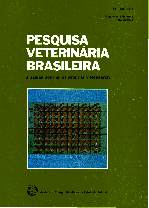 |
|
|
|
Year 1998 - Volume 18, Number 2
|

|
Experimental poisoning by Baccharis coridifolia (Compositae) in cattle, 18(2):69-75
|
ABSTRACT.- Varaschin M.S., Barros C.S.L. & Jarvis B.B. 1998. [Experimental poisoning by Baccharis coridifolia (Compositae) in cattle.] Intoxicação experimental por Baccharis coridifolia (Compositae) em bovinos. Pesquisa Veterinária Brasileira 18(2):69-75. Depto Patologia, Universidade Federal de Santa Maria, Santa Maria, RS 97119-900, Brazil.
Thirteen calves were fed single doses varying from 0.5 to 5g/kg of either freshly harvested or dried Baccharis coridifolia. One calfwas fed 4 daily doses of 0,5g/kg of the dried plant. Two calves did not receive the plant and served as controls. The plant material was harvested each month from July 1991 to May 1992 and then in March 1993, and was analysed for its contente in macrocyclic trichothecenes. When in flower the female and mate plant specimens were both analysed and fed separately to calves. The levels of macrocyclic trichothecenes and their glucosides were much higher in the flowering female plants compared with the levels observed in those plants not in flower and in the flowering male plants. Ten calves either died or were euthanatized due to the toxicosis. Two calves fed the female flowering plant got sick and died, while 3 calves fed the flowering male plant did not develop the toxicosis. Clinical signs in the poisoned calves were anorexia, dehydration, ruminal atony, abdominal distension and pain, liquid diarrhea, dry muzzle, imbalance in the hindlimbs and sternal recumbency. Main pathological findings included necrosis of the gastrointestinal tube, particularly in the forestomachs and in the lymphoid tissues except for the thymus. The latter suggests an effect upon the B cells of the lymphoid tissue. The distribution of the lesions in the digestive and lymphoid systems was sistematicaily determined. lt is concluded that the macrocyclic trichothecenes present in the plant account for the lesions observed in the toxicosis and that the female flowering plant is substantially more toxic than the flowering mate plants or plants not in flower. This difference in toxicity is due to the difference in macrocyclic trichothecenes contents. |
| |
|
|
| |
|
 |